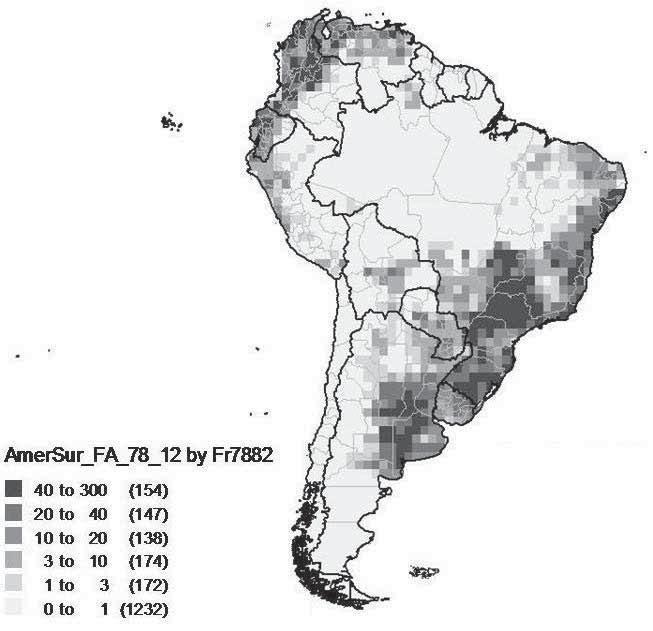
35 minute read
The Hemispheric Program for the Eradication of Foot-and-Mouth Disease
Fig. 3 Cumulative weekly reports of FMD outbreaks 1978-1982
J. Naranjo y A. Mendes. Epidemiology Unit. PANAFTOSA OPS/OMS Source: reports of the Veterinary Services to the epidemiological information and surveillance system (SIVCONT) of PANAFTOSA
Advertisement
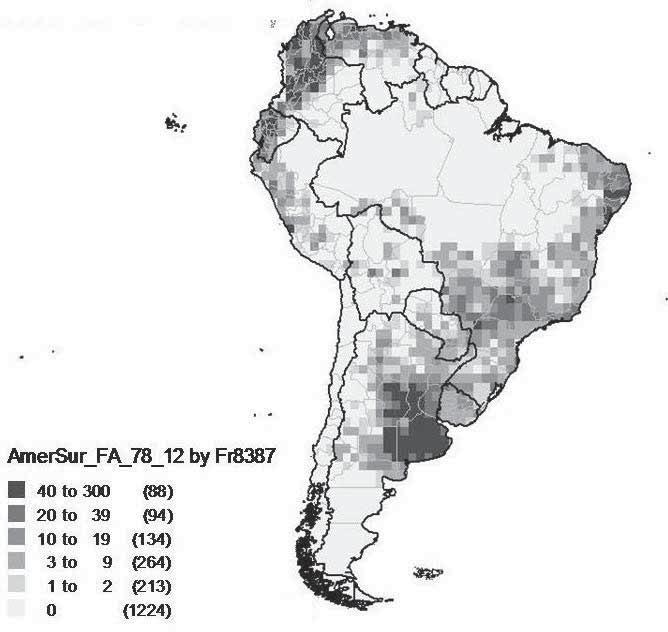
Fig. 4 Cumulative weekly reports of FMD outbreaks 1983-1987
J. Naranjo y A. Mendes. Epidemiology Unit. PANAFTOSA OPS/OMS Source: reports of the Veterinary Services to the epidemiological information and surveillance system (SIVCONT) of PANAFTOSA
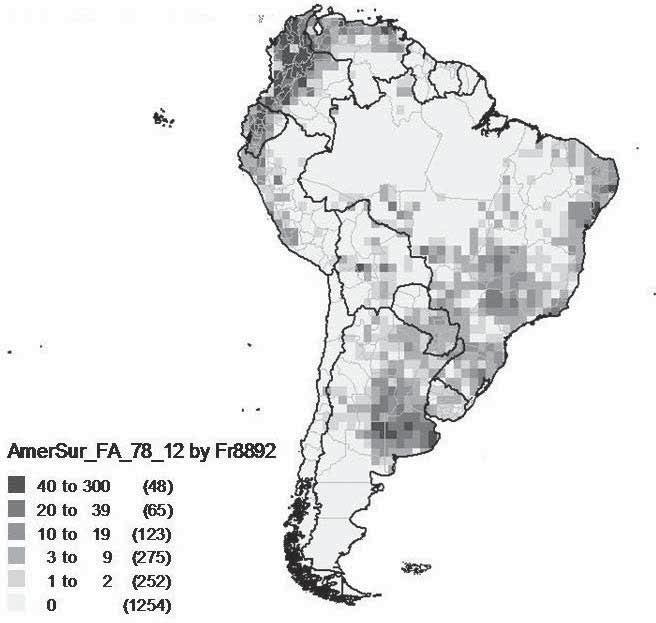
Fig. 5 Cumulative weekly reports of FMD outbreaks 1988-1992
J. Naranjo y A. Mendes. Epidemiology Unit. PANAFTOSA OPS/OMS Source: reports of the Veterinary Services to the epidemiological information and surveillance system (SIVCONT) of PANAFTOSA
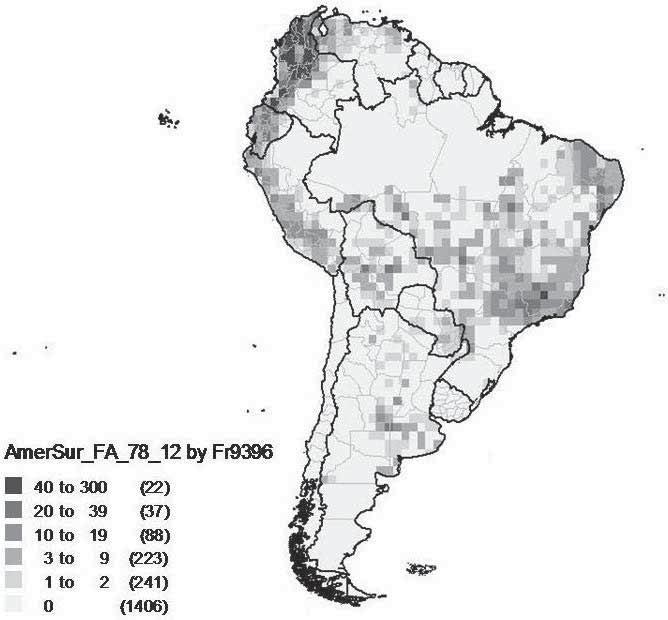
Fig. 6 Cumulative weekly reports of FMD outbreaks 1993-1996
J. Naranjo y A. Mendes. Epidemiology Unit. PANAFTOSA OPS/OMS Source: reports of the Veterinary Services to the epidemiological information and surveillance system (SIVCONT) of PANAFTOSA
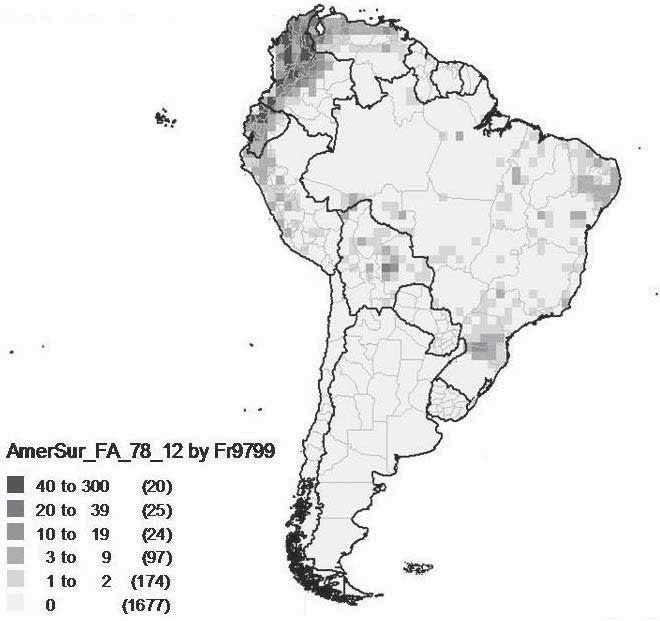
Fig. 7 Cumulative weekly reports of FMD outbreaks 1997-1999
J. Naranjo y A. Mendes. Epidemiology Unit. PANAFTOSA OPS/OMS Source: reports of the Veterinary Services to the epidemiological information and surveillance system (SIVCONT) of PANAFTOSA
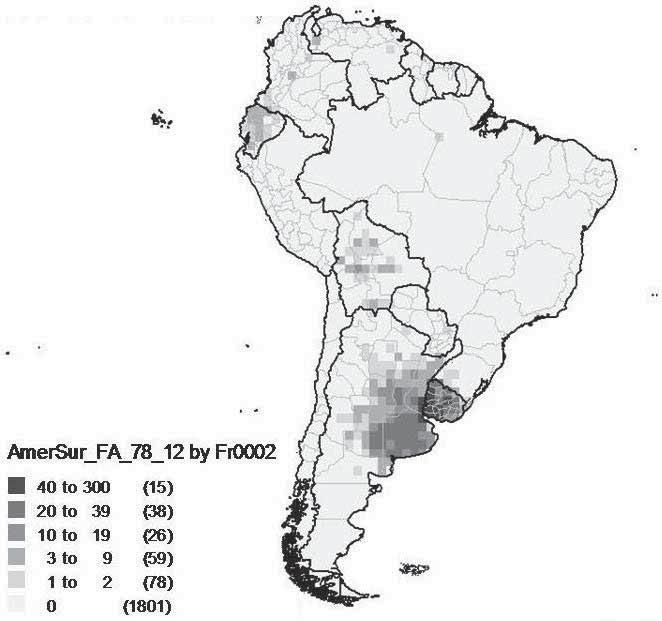
Fig. 8 Cumulative weekly reports of FMD outbreaks 2000-2002
J. Naranjo y A. Mendes. Epidemiology Unit. PANAFTOSA OPS/OMS Source: reports of the Veterinary Services to the epidemiological information and surveillance system (SIVCONT) of PANAFTOSA

Fig. 9 Cumulative weekly reports of FMD outbreaks 2003-2007
J. Naranjo y A. Mendes. Epidemiology Unit. PANAFTOSA OPS/OMS Source: reports of the Veterinary Services to the epidemiological information and surveillance system (SIVCONT) of PANAFTOSA

Fig. 10 Cumulative weekly reports of FMD outbreaks 2008-2011
J. Naranjo y A. Mendes. Epidemiology Unit. PANAFTOSA OPS/OMS Source: reports of the Veterinary Services to the epidemiological information and surveillance system (SIVCONT) of PANAFTOSA

Fig. 11 Cumulative weekly reports of FMD outbreaks 2012-2013
J. Naranjo y A. Mendes. Epidemiology Unit. PANAFTOSA OPS/OMS Source: reports of the Veterinary Services to the epidemiological information and surveillance system (SIVCONT) of PANAFTOSA*
18,000
16,000
14,000
12,000
10,000
8,000
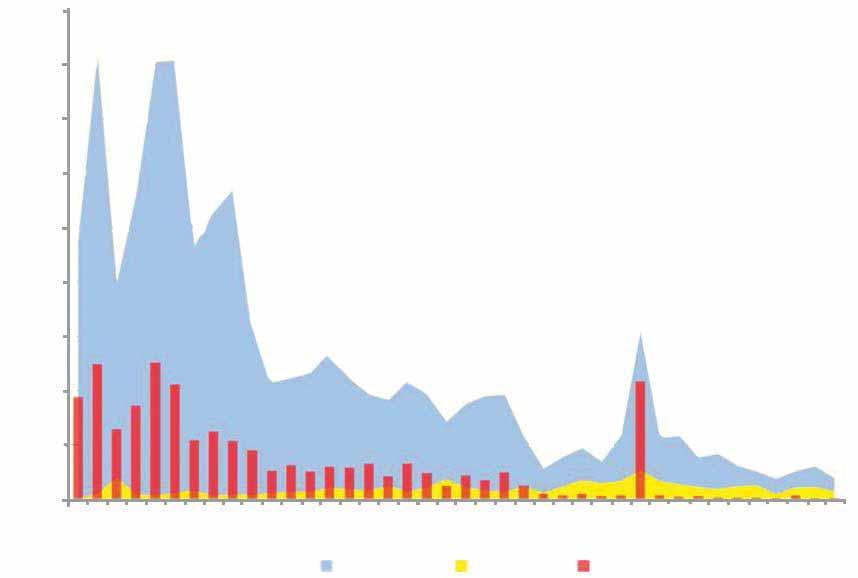
6,000
4,000
2,000
0
19851984198319821981198019791978197719761975197419731972 198619871988198919901991199219931994 19961997199819992000200120022003200420052006200720082009201020111995
Vesicular diseases Vesicular stomatitis FMD
Fig. 12 Reported cases of vesicular disease, foot and mouth disesase, vesicular stomatitis
Continental epidemiological surveillance and information system (SIVCON)
5,000
4,500
4,000
3,500
3,000
2,500
2,000

1,500
1,000
500
0 19851984198319821981198019791978197719761975197419731972 198619871988198919901991198219931994 19961997199819992000200120022003200420052006200720082009201020111995
Fig. 13 Reported cases of type O, A, C FMD virus
Continental epidemiological surveillance and information system (SIVCON)
OIE Global FMD Strategy, along with reiterating that COSALFA, COHEFA, GIEFA and RIMSA are the governance mechanism of PHEFA (20). The Plan of Action 2011–2020 is facing a number of challenges. In the Southern Cone the emergence of sporadic outbreaks still needs to be resolved (Fig. 14), particularly those of unknown origin in areas previously recognised as disease free. Such sporadic outbreaks might be a consequence of a concurrent very low level of virus circulation in the bovine population along with insufficient levels of herd immunity to halt virus circulation. This scenario highlights deficiencies in the quality of interventions and the sensitivity of the detection and response systems. Key amendments towards improving interventions in the areas of production where there is risk of viral circulation include implementing targeted risk-based interventions, strengthening the structure and capacity of Veterinary Services to monitor vaccination where practised, and implementing effective surveillance, early detection and response of suspected cases, and prompt reporting and notification. It should also be mentioned that there have been very few instances when the disease was not promptly reported internationally. Such situation has some similarity with the FMD epidemic of 2000–2001, which occurred in previously free territories without vaccination and was first reported by farmers and at a later stage notified internationally. On the other hand, the advances achieved in the population which is disease free with vaccination are sustained by the systematic mass vaccination campaigns, with the application of 700 million annual doses, fully financed by livestock producers. For the livestock producers, it is increasingly difficult to appreciate the need for continuing vaccinations, since in the majority of the territories that have achieved the status of disease free with vaccination the disease has not been detected for more than ten years. Furthermore, the vaccination campaigns have become routine and are not applied as a strategic tool tailored to the epidemiological risk of the prevailing sanitary scenarios to interrupt the epidemic cycle of the disease and prevent the reintroduction of the infection. Figure 15 reports the FMD situation in South America according to the OIE in May 2012. At the time of the last review of this paper (February 2015), South America has reached the historical goal of three consecutive years without an FMD outbreak detected or reported. Paraguay, following its last outbreak (San Pedro, January 2012), regained its ‘free with vaccination’ OIE status. Argentina and Peru increased their territories with ‘free without vaccination’
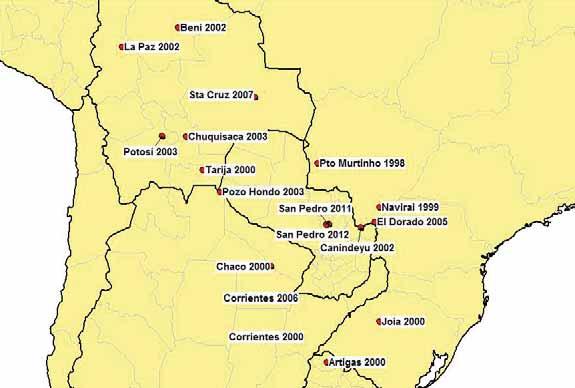
Fig. 14 Selected reports of FMD virus type O occurrence in the countries of the Southern Cone of South America, 1998-2012
Fig. 15 FMD situation in South America according to the OIE, May 2012
Free zone without vaccination Free zone with vaccination Not free Protection zone Suspended status
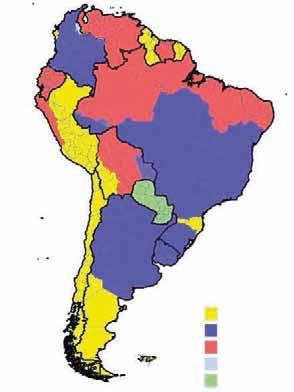
Source: Epidemiological unit, PANAFTOSA, OPS/OMS
OIE status. Bolivia was recognised by the OIE as ‘free with and without vaccination’. Eight north-eastern Brazilian States were recognized as ‘free with vaccination’ by OIE. Ecuador submitted a dossier to the OIE to be considered ‘free with and without vaccination’. Finally, Venezuela submitted its FMD national eradication programme for OIE endorsement. Systematic mass vaccination needs to be maintained at the current level because of the persistence of the infection in South America. However, the perception of the livestock producers of a lack of progress in the sanitary condition along with their expectations for better commercial opportunities could easily discourage the maintenance of high vaccination coverage. This could lead to an increased susceptibility of the population to disease, increasing the risks of infection and of an eventual reappearance of the disease along with the consequent sanitary setbacks that would dramatically jeopardise all the efforts and progress to date. Available information shows that in some countries the declared vaccination coverage does not reflect the real herd immunity. Some areas could have lower vaccine coverage, especially areas with small livestock producers and where the disease has not been recorded for more than 15 years. Progress with the remaining 15% of the livestock population that is not FMD free is not a simple issue to address in the short term. The most difficult challenges that require full resolution include maintaining the political commitment and support of the national governments; obtaining the allocation of national resources to sustain the elimination programmes; and obtaining the international support and solidarity of human and financial resources to provide technical cooperation for elimination. Realistically, these challenges can be managed in the medium term (four to six years).
Challenges of the Plan of Action 2011–2020 of the Hemispheric Program for the Eradication of Foot-and-Mouth Disease
The national FMD elimination programmes need strengthening on several of their strategic components or require changes in order to address the new epidemiological scenarios, both in countries and areas with presence of the infection and in those countries that need to consolidate the advance from disease free with vaccination to disease free without vaccination. The following sections review the most critical strategic components with regard to the support that these provide to the programmes, such as systematic vaccination, laboratory diagnosis, surveillance systems, alert and response, prevention, human resources and community participation. The vaccination campaigns need strengthening in countries where the risk of virus circulation is still present. There are weaknesses with the conservation and application of the vaccine and a weak correlation between the official vaccination coverage and the level of immunity of the population. Deficiencies in the planning of the vaccination campaigns are also observed as they do not consider the epidemiological situation and the risk characterisation. In addition, with very few exceptions, there are no vaccine and antigen banks, which are required to respond to emergency demands due to a South American virus strain or introduction of exotic viruses into the region. To reach elimination, a large animal population needs to move its sanitary status from disease free with vaccination to free without vaccination. Such a change poses perhaps the greatest managerial and operational challenge, as it requires that the population remain without vaccination, rapidly increasing its susceptibility to the variants of the virus circulating in the region. The adverse experiences of the Southern Cone have indicated that the processes of withdrawing the vaccine should be extremely carefully planned. Emergency plans are highly necessary, with vaccines banks aligned with the risk profile of the region. The establishment of antigen banks is also needed to rapidly prepare specific monovalent vaccines in order to respond to outbreaks when they arise. With regard to laboratory diagnosis there are deficiencies in some countries on the implementation of rapid viral diagnostic techniques for identification of the FMD virus, on the biosafety of the infrastructure, as well as on the mechanisms and capacities required to shorten the time from clinical detection to diagnosis. In addition, there is the need for further studies for the standardisation of the diagnostic kits recently introduced in the region for determining viral circulation and evaluating the immunity of the population. With regard to the national information systems, increasingly there is the need to have access to historical and real-time data in order to effectively manage the intervention activities and to provide transparency. In this regard, the existing regional information system, SIVCON (8), would need to be further used by the countries. Deficiencies are also present in the utilisation of the data collected at the local level, the standardisation of data collection and the criteria for analysis.
In addition to strengthening technical and managerial capacities, the processes of intervention should be accompanied by a policy of continuous professional development of the human resources responsible for managing interventions, at the national and sub-national levels. In this regard, there is a shortage of human resources in the official Veterinary Services caused by the departure of experienced and knowledgeable professional staff due to movement to other jobs or retirement, failure to recruit new staff for key vacant posts due to budgetary constraints, and, finally, the recruitment of new professional staff with limited experience in FMD. Furthermore, there are changes in the official Veterinary Services, which are moving from an emphasis on improving the sanitary status based on control and elimination programmes, to an emphasis on ensuring the sanitary status in order to support the export process. There are also changes in the general profile of the veterinarians, with new staff lacking the necessary experience and having a critical role, particularly in facing the challenge of moving from the status of disease free with vaccination to that of disease free without vaccination. It is urgent and necessary to establish training and continuing professional development programmes to build analytical capacities and risk management, assessment and communication competencies tailored to the field situations and to progress the national programmes. With regard to the disease surveillance, detection and response systems, given the progress of the programmes, the limited occurrences of outbreaks in the majority of countries, and the significant changes in the professional profiles of the staff of the official Veterinary Services, there is a need for training when introducing new tools to increase the sensitivity of detection mechanisms, in particular the use of geographic information systems and spatial risk analysis. With regard to the need to increase the sensitivity of the detection mechanism, this also requires a much greater participation of the livestock producers and other stakeholders for reporting signs compatible with vesicular diseases. However, the majority of countries do not have specific mechanisms to promote the notification of suspected disease, such as compensation or indemnity. Given the prolonged absence of detection of clinical disease and the absence of viral circulation shown by successive sero-epidemiological studies, several sub-national authorities and organisations of livestock producers are now requesting their authorities to move forward with elimination and are carrying out feasibility studies in order to end vaccination and apply for FMD free without vaccination status. They cite the state of Santa Catarina, Brazil and Chile as examples to be imitated. However, national authorities do not have sufficient information on the characterisation of risk in order to evaluate the epidemiological, operational and economic feasibility required for this change. Some also recall with great concern the failure of the previous experiences of moving towards free without vaccination status, along with the serious economic consequences. Ensuring that decision-makers at political level understand the essential need for establishing rigorous prevention programmes along with effective outbreak alert and response mechanisms is a challenge. These prevention programmes require financial, human and material resources in order to prepare the official Veterinary Services for a scenario without vaccination and a population with maximum susceptibility.
Conclusions
The results achieved so far by the two Plans of Action of PHEFA can be regarded as very positive. Systematic mass vaccination proved to be an effective tool for the elimination of FMD in South America. The establishment of the two Plans of Action was essential for the countries to address with clear and coordinated actions the elimination process through an international technical cooperation framework. The established political, strategic and technical governance mechanisms (i.e. COSALFA, COHEFA, GIEFA, RIMSA) provided continuous monitoring of the FMD elimination plans and actions; and also promoted and articulated the private–public partnership. The effectiveness of this governance architecture is proven by the significant advances towards elimination in the majority of countries of South America. The establishment of the Plans of Action of the PHEFA is the expression of the political will of the governments that provide support and incentives to the various stakeholders of the livestock production chain within the spirit of cooperation and solidarity for the common good. Concluding the unfinished task of FMD elimination from South America requires strengthening of the national FMD elimination programmes and technical cooperation, along with the collective and effective technical and financial assistance to priority countries. The experience acquired in the execution of the two Plans of Action of the PHEFA indicates that it is feasible to eliminate FMD from the continent. The challenge is to use this experience in the areas where implementation had not reached an adequate level of execution.
References
1. Astudillo V. (1984). – Formas de organização da produção como determinante do risco de febre aftosa. Hora Vet. 3, 45–52. 2. Astudillo V. (1992). – La fiebre aftosa en América del Sur. Hora Vet. 70, 16–20. 3. Astudillo V. & Augé de Mello P. (1980). – Análisis del costo y de la efectividad de dos procedimientos de vacunación antiaftosa. Bol. Cent. Panam. Fiebre Aftosa, 37–38, 49–55. 4. Casas Olascoaga R., Gomes I., Rosenberg F.J., Auge de Mello P., Astudillo V. & Magallanes N. (1999). – Fiebre aftosa. São Paulo, Atheneu. 5. Correa Melo E., Saraiva V. & Astudillo V. (2002). – Review of the status of foot and mouth disease in countries of
South America and approaches to control and eradication. In Foot and mouth disease: facing the new dilemmas (G.R. Thomson, ed.). Rev. Sci. Tech. Off. Int. Epiz., 21 (3), 429–436. 6. Food and Agriculture Organization of the United Nations (FAO) (2011). – Production. Livestock primary, 2008.
Food and Agriculture Organization Corporate Statistical Database (FAOSTAT). Rome, Italy. 7. Food and Agricultural Organization of the United Nations (FAO) and World Organisation for Animal Health (OIE) (2012). – Global Foot and Mouth Disease Control Strategy. Available at: www.oie.int/eng/A_FMD2012/Docs/
Altogether%20FMDcontrol_strategy27June.pdf (accessed on 19 April 2013). 8. Mendes da Silva A.J., Brasil E., Saraiva V., Darsie G. & Naranjo J. (2011). – SIVCONT epidemiological information and surveillance system. In Challenges of animal health information systems and surveillance for animal diseases and zoonoses. Food and Agriculture Organization of the United Nations (FAO), 57–62. 9. Ministry of Agriculture, Livestock and Food Supply of Brazil & Pan American Foot-and-Mouth Disease Center (PANAFTOSA) (2007). – Assessment of the population immunity deriving from the vaccination campaigns against foot and mouth disease: final report. Brasília, DF, MAPA. 10. Obiaga J.A., Rosemberg F., Astudillo V. & Goic R (1979). – Las características de la producción pecuaria como determinantes de los ecosistemas de la fiebre aftosa. Bol. Cent. Panam. Fiebre Aftosa, 33–34, 33–42. 11. Pan American Foot-and-Mouth Disease Center (PANAFTOSA) (1973). – Lucha contra la fiebre aftosa en América del Sur (Quinquenio 1967–1971). Pan American Foot-and-Mouth Disease Center (PANAFTOSA)–Pan American
Health Organization (PAHO)/World Health Organization (WHO), Rio de Janeiro. 12. Pan American Foot-and-Mouth Disease Center (PANAFTOSA) (1983). – Hechos y progresos en fiebre aftosa en
América del Sur durante el período de 1971-1981. Pan American Foot-and-Mouth Disease Center (PANAFTOSA)–
Pan American Health Organization (PAHO)/World Health Organization (WHO), Rio de Janeiro. 13. Pan American Foot-and-Mouth Disease Center (PANAFTOSA) (1991). – Panaftosa, 40 años al servicio de las
Américas. Pan American Foot-and-Mouth Disease Center (PANAFTOSA)–Pan American Health Organization (PAHO)/World Health Organization (WHO), Rio de Janeiro. 14. Pan American Health Organization (PAHO) (1985). – Caracterización de los ecosistemas de fiebre aftosa. Pan
American Foot-and-Mouth Disease Center (PANAFTOSA)–Pan American Health Organization (PAHO)/World Health
Organization (WHO), Rio de Janeiro. 15. Pan American Health Organization (PAHO) (1988). – Actas de la Reunión del Comité Hemisférico para la
Erradicación de la Fiebre Aftosa (COHEFA) Washington, DC, 6–7 July 1988. Pan American Foot-and-Mouth
Disease Center (PANAFTOSA)–Pan American Health Organization (PAHO)/World Health Organization (WHO), Rio de Janeiro. 16. Pan American Health Organization (PAHO) (2004). – Declaración de Houston: aprobada en la conferencia hemisférica sobre la erradicación de la fiebre aftosa, Houston, Texas, 3 y 4 de marzo de 2004. Pan American
Foot-and-Mouth Disease Center (PANAFTOSA)–Pan American Health Organization (PAHO)/World Health
Organization (WHO), Rio de Janeiro. 17. Pan American Health Organization (PAHO) (2006). – Situación de los programas de control de fiebre aftosa.
América del Sur 2005. Pan American Foot-and-Mouth Disease Center (PANAFTOSA)–Pan American Health
Organization (PAHO)/World Health Organization (WHO), Rio de Janeiro. 18. Pan American Health Organization (PAHO) (2010). – Situación de los programas de control de fiebre aftosa.
América del Sur 2009. Pan American Foot-and-Mouth Disease Center (PANAFTOSA)–Pan American Health
Organization (PAHO)/World Health Organization (WHO), Rio de Janeiro. 19. Pan American Health Organization (PAHO) (2011). – Situación de los programas de control de fiebre aftosa.
América del Sur 2010. Pan American Foot-and-Mouth Disease Center (PANAFTOSA)–Pan American Health
Organization (PAHO)/World Health Organization (WHO), Rio de Janeiro.
20. Pan American Health Organization (PAHO) (2012). – 12ª reunión ordinaria del Comité Hemisférico de Erradicación de la Fiebre Aftosa, Santiago, Chile 24 de julio 2012. Resoluciones de la COHEFA 12. Pan American Foot-and-
Mouth Disease Center (PANAFTOSA)–Pan American Health Organization (PAHO)/World Health Organization (WHO), Rio de Janeiro. 21. Pan American Health Organization (PAHO) (2013). – Situación de los programas de control de fiebre aftosa de los países en el Continente Americano 2012. Pan American Foot-and-Mouth Disease Center (PANAFTOSA)–Pan
American Health Organization (PAHO)/World Health Organization (WHO), Rio de Janeiro. 22. Programa Hemisférico de Erradicación de la Fiebre Aftosa (PHEFA) (2010). – Plan de Acción del PHEFA, 2011–2020. Pan American Foot-and-Mouth Disease Center (PANAFTOSA)–Pan American Health Organization (PAHO)/
World Health Organization (WHO), Rio de Janeiro. 23. Saraiva V. & Darsie G. (2004). – The use of vaccines in South American foot-and-mouth disease eradication programmes. Dev. Biol. (Basel), 119, 33–40.
Global foot and mouth disease portfolio review
N. Leboucq (1) & B. Todeschini (2)
(1) World Organisation for Animal Health (OIE) Sub-Regional Representation in Brussels, 40 rue Breydel, Brussels, Belgium. (2) World Organisation for Animal Health (OIE), 12 rue de Prony, 75015, Paris, France.
Summary
The Global Framework for the progressive control of Transboundary Animal Diseases (GF-TADs) foot and mouth disease (FMD) Working Group carried out a survey to collate and analyse the portfolio of FMD activities worldwide. The survey was sent to 99 developing and in-transition countries as well as to ten development partners and 17 global and regional organisations active in the animal health field. A total of 121 completed questionnaires were received. The results should be interpreted carefully, since they are based on preliminary and fractional data. Only the following general trends can be concluded. Projects (in numbers) are distributed inequitably across all regions, with a clear gap in interventions in West Eurasia and most of Africa (virus Pools 3, 4 and 5). FMD is tackled mostly at a national level. Twelve FMD projects are in the pipeline. The project starting dates indicate that the portfolio develops mainly in response to ongoing FMD events, following the pattern of FMD epidemics. The portfolio amounts to US$ 7.8 billion, showing regional disparities. Most FMD activities are financed by the countries themselves (America, Asia and the Middle East). On the contrary, in Africa and Europe (non-EU Member States), FMD activities are financed predominantly through external aid. This external aid accounts for US$ 330 million and is quite equitably distributed between Africa, Asia and Europe (non-EU Member States). The EU is the main development partner. The Food and Agriculture Organization of the United Nations (FAO) and regional banks also have a sizeable FMD portfolio. On the other hand, several development partners indicate no financing of FMD projects. Most of the projects are aimed at the progressive control of FMD among domestic species. However, in America, most projects aim to maintain an OIE official ‘free’ status, while in Europe (non-EU Member States), emergency support is the first objective of many projects. Rapid response and laboratory, epidemiology and Veterinary Services activities are carried out in more than 60% of projects, while compensation, research and coordination activities are rarely implemented. Finally, the use of the FAO–World Organisation for Animal Health (OIE) Progressive Control Pathway (PCP) for FMD and the OIE Performance of Veterinary Services (PVS) tools are hardly mentioned.
Keywords
Foot and mouth disease – Funding-survey – Portfolio – Projects.
Introduction
As part of the preparatory work to support the elaboration of the Food and Agriculture Organization of the United Nations (FAO)/World Organisation for Animal Health (OIE) Global Strategy for the control of foot and mouth disease (FMD) (hereafter ‘FMD strategy’), the Global Framework for the progressive control of Transboundary Animal Diseases (GF-TADs) FMD Working Group carried out a survey to collate and analyse the FMD portfolio of activities worldwide, with the following objectives: − identify the funds already committed and/or disbursed in the prevention and control of FMD worldwide, with a view to fine-tuning the overall budget of the Action Plan (Part B) and identifying the financial gaps; and − identify possible gaps and overlaps in FMD prevention and control activities, as a transparent and rational basis for improving coordination at regional and global levels.
The survey was based on a questionnaire composed of 12 questions. It was sent out through the OIE delegates to a selection of developing and in-transition countries (99 in total) facing a wide range of situations with regard to FMD and, in particular, where FMD is known to be present (either enzootic or epidemiological events). Japan was also included to have a concrete example from a developed country. The same questionnaire was also sent to ten development partners and 17 regional organisations active in the field of animal health, to try to cross-check the information provided by the countries and make the portfolio review as comprehensive as possible. A total of 121 questionnaires were received from 63 respondents, namely 45 countries (45%), eight development partners (80%) and ten global and regional organisations (59%). Unfortunately, some major donors did not respond. The authors took the liberty to complete and add data, whenever aware of them. The results presented below are based on preliminary and partial data and should therefore be interpreted carefully. Only general trends can be concluded.
Results
The results of the survey show that despite a sizeable FMD portfolio composed of approximately 30 ongoing projects, endemic regions in Central Asia, Western and Central Africa and Eastern Africa, corresponding to FMD virus Pools 3, 4 and 5, are not well covered. Projects that operate in the same regions often have different timescales and activities, generally preventing overlaps (it is not possible to say whether there are attempts to exploit synergies among different projects). Twelve FMD projects are in the pipeline, mainly linked to new epidemiological situations (Southern African Territories [SAT] 2 in Egypt and neighbouring countries, for instance) and to new provisions in the OIE Terrestrial Animal Health Code (Chapter 8.5.23) encouraging countries to develop and implement national FMD control programmes endorsed by the OIE. The majority of FMD projects operate at country level (68%) and few multi-country and (sub)regional FMD projects exist. The optimal level of intervention for FMD, however, is known to be sub-regional, in particular when these match the virus pools’ geographic areas. The timeframe of new projects shows that they usually follow the pattern of FMD epizootics in the regions, confirming that this is an ‘in reaction to’ portfolio: peaks of projects occur in 2001–2002, 2006–2007 and 2010, when Europe, America and Asia, respectively, faced important FMD epizootics. Large amounts of funds (the portfolio amounts to approximately US$ 8 billion – with the limitation that developed countries were not included in the survey except Japan) are spent worldwide to control the disease, with strong regional disparities: 98% of the funds are spent in America (77%) and Asia (21%), with three countries (Japan, Brazil and Argentina) sharing more than 80% of this budget, in an effort to maintain/recover their FMD free without vaccination status. Ninety-four per cent of FMD control funds come from national sources (self-financing), from both state budgets and private operators’ contributions. The donor portfolio (external aid) is very small (4% of total funds, corresponding to US$ 330 million). Nevertheless, in Africa and Europe (non-EU Member States), most FMD activities are conditioned to external aid. The EU is by far the biggest donor with respect to FMD project funding and significantly intervenes in Africa, Asia and Europe. The FAO also has a sizeable portfolio of FMD projects in all regions, as well as regional banks. Conversely, other donors that are usually active in the field of animal health do not have any FMD-related activities in their portfolio. Project support (‘standalone + component’) remains the preferred financial channel (91%) to carry out FMD activities in all regions. America is the region where budget support is most used, even if it remains limited (16%). In most cases, FMD standalone projects (mono-disease projects) are developed. However, in Asia (50%) and Europe (40%), as well as for multi-region projects (50%), a more transversal approach integrating FMD as a component of a wider animal health programme/project is adopted. This is consistent with component three of the global FMD strategy, combining as often as possible FMD with other transboundary animal disease (TAD) prevention and control measures. Projects focusing solely on FMD are more numerous than transversal approaches, which combine FMD and other TAD control activities. The majority of projects (77%) have a medium- to long-term development objective, aimed in most cases (43%) at the control of the disease in endemic zones, corresponding to countries in Stages 1, 2 and 3 of the Progressive
Control Pathway for FMD (PCP-FMD). Emergency support is also provided in Asia (29%) and Africa (28%) and to a lesser extent in the other regions, except the Middle East. In America, maintaining an OIE official free status logically represents the objective of 70% of the projects carried out. In terms of FMD activities conducted, activities such as rapid response activities, prevention, early detection, Veterinary Services, laboratory and epidemiology are present in more than 60% of FMD projects. It is interesting to note that epidemiology is implemented in 60% of projects, probably linked to activities in wildlife. On the other hand, compensation activities receive very little to no interest at all (14%), as well as research (30%) and coordination (36%). The latter is difficult to understand in the context of a highly contagious TAD. All regions give priority to the reinforcement of Veterinary Services, except America. This is in line with the approach proposed by the global FMD strategy (component two) where the reinforcement of Veterinary Services is seen as a condition of the efficiency and sustainability of FMD measures put in place (‘enabling environment’). In America – where the situation is no longer endemic – and Europe, priority is given to rapid response activities, including emergency vaccination. Communication activities are of utmost importance in Europe (in 80% of projects), but are rather neglected in other regions. Domestic animals/livestock are by far the main target of the programmes/projects. No project addresses wildlife alone, but in the Middle East and Africa, 33% and 48% of projects, respectively, jointly address livestock and wildlife species (surveillance/epidemiology activities). This is all the more important in Africa when we consider the important role played by the African buffalo in the maintenance and spread of FMD. The PCP-FMD and OIE Performance of Veterinary Services (PVS) are rarely mentioned as tools supporting FMD control activities. It is hypothesised, however, that these were developed too recently to be taken into account by the projects included in the survey. Many other important ‘tools’ for the prevention and control of FMD were listed by the respondents, including vaccines and antigens banks, progressive zoning approach, value-chain analysis and the animal disease spread model (NAADSM).
Conclusions
At the national level, FMD activities can be efficiently implemented only if: − they are embedded into a national FMD control strategy/plan, − they are jointly elaborated by all stakeholders involved and − they rely on strong epidemiological data and risk analysis. These national plans should clearly reflect the principles laid out in the global FMD control strategy and have the overall objective to progress at least two PCP-FMD stages over the next 15 years. FMD projects should also be backed up by a comprehensive legal framework where the roles and responsibilities of each stakeholder are clearly identified. The role of the private sector is key for both the funding (cost-sharing schemes) and the implementation of FMD control activities. Therefore, strong animal health systems should be the basis of FMD control activities in all countries and driven by reinforced Veterinary Services, supported by functional Veterinary Statutory Bodies (or equivalent structures). The use of the OIE PVS Pathway is key for this purpose. The level of awareness and commitment of policy-makers should remain high, even in countries where the disease is under control. The preliminary results of the portfolio show that the investments in FMD control worldwide are high, but such investments appear to be made mainly by the countries that see clear trade incentives. Developing countries are investing much less in FMD control, probably because they cannot afford it or fail to see a positive cost–benefit balance.
International investments are limited and appear insufficient to considerably progress with FMD control in the near future. To correct this situation, additional investments will be necessary, in particular in the countries belonging to FMD virus Pool regions 3, 4 and 5 where few FMD projects appear to be ongoing or in the pipeline. Support for national programmes is needed but regional support should also be increased. External aid can bring seed money and play a catalytic role in national projects and this can also be done through supporting regional and global activities. Notably, the upscaling of national and regional activities can be obtained through capacity building. In this regard, regional and international networking activities will allow economies of scale. All these programmes would be aligned to the Global Strategy, which uses FMD as an entry point for reinforcement of Veterinary Services and improved prevention and control of other TADs.
The impact of foot and mouth disease
J. Rushton (1) & T. Knight-Jones (2)
(1) Royal Veterinary College, Hawkshead Lane, North Mymms, Hatfield, Hertfordshire AL9 7TA, United Kingdom (2) International Livestock Research Institute, Lusaka, Zambia Correspondence: jrushton@rvc.ac.uk
Summary
The global impact of foot and mouth disease (FMD) is colossal because of the huge numbers of animals affected. This impact can be separated into two components: direct losses due to a reduction in production and changes in herd structure; and indirect losses that relate to the significant costs of FMD control and management and poor access to markets and limited use of improved production technologies. The paper estimates that the annual impact of FMD in terms of production losses and vaccination alone are in the region of US$ 5 billion.
Keywords
Economics – Foot and mouth disease – Global – Impact assessment.
Introduction
Foot and mouth disease (FMD) is endemic in almost all developing countries. The seven different FMD serotypes circulate within regional viral pools with periodic incursions into virus-free developed countries. FMD causes high morbidity and low mortality, although high mortality among young stock does occur. Clinical signs are generally more severe in temperate breeds associated with intensive farming, particularly in immunologically naive populations. The disease affects all the major non-avian livestock species, with cattle being the most susceptible and pigs the best amplifier of virus. Infection in wildlife can further complicate control efforts. When this ease of biological transmission is combined with widespread and long-distance movements of animals, FMD can move quickly and spread effectively. The importance of trade, both legal and illegal, in the spread of the disease implies that any FMD control strategy must have policies and actions to limit risks of FMD spread from an outbreak and the introduction from neighbouring countries and trading partners. These movement controls for FMD management have an economic impact of limiting trade that is local, national and international in its reach. The most extreme and costly impacts are the lack of access to lucrative international markets for countries where FMD is not controlled.
The paper presents the main impacts of FMD from production losses, costs of control, poor technology development and trade. It uses a framework to assess the impact of disease (see Rushton, 2009, pages 193–197 [12]). It also makes an estimate of the global impact of the disease in terms of production losses and vaccination costs.
Economic impact of foot and mouth disease
Although other diseases can cause more severe disease in individuals, in order to appreciate the impact of FMD, one must step back and look at the disease at the population level. FMD is widely prevalent, with the disease circulating in an estimated 77% of the global livestock population. In this population it affects a large proportion of animals during an outbreak and affects many species. Collectively, these factors lead to a huge burden of disease.
Direct costs – visible and invisible losses
Production losses directly due to FMD include: − reduced milk production, affecting both the humans and calves that depend on it. This can account for 33% of losses in endemic settings; − reduced livestock growth; − mortality among young stock, typically reported to be between 2% and 5%; − loss of traction power where draught animals are used. If this occurs during harvest the effects can be particularly severe (9, 11); − abortion: the cost of a single abortion is high as the farmer will have to pay to keep the cow without it producing anything for another year or more, or cull the animal; − although FMD typically has a short-term effect on an animal’s health, chronic FMD typically reduces milk yields by 80% (1, 2, 3, 15). Visible production losses are most prominent in pigs in intensive production systems followed by dairy cattle. These two systems are important sources of animal protein in poor countries and their importance continues to grow. Extensive systems of production do not have such pronounced losses, and some species, such as sheep and goats, show limited clinical symptoms and minor economic losses. Foot and mouth disease (FMD) causes problems which are less easily quantified. With fertility, the most obvious problems are the abortion losses explained above, but there are longer lasting impacts of this loss of foetus and a reduced probability of conception. These both translate into the need to have a greater proportion of breeding animals in a population, implying that for every kilogram of meat or milk produced there is an additional fixed cost to cover more breeding stock.
Indirect costs – additional costs and revenue forgone
The cost of control measures carried out by the state Veterinary Services, such as vaccination, outbreak control and sometimes culling and compensation, are borne by the tax payer. − An estimated 2.6 billion doses of FMD vaccine are administered annually (8), with vaccine drug and delivery costs at between US$ 0.4 and US$ 3 per dose including delivery costs, depending on the setting (1, 4, 13). − Some national FMD vaccination programmes vaccinate all bovines three times a year and all sheep and goats once a year, which limits resources available to combat other diseases. − In endemic settings significant amounts are spent on privately funded vaccination and control. − In some areas, wildlife is kept out of FMD-free zones with extensive fencing at great financial cost, not to mention the impact this restriction has on wildlife. In Africa, it has been estimated that more is spent on controlling FMD than on any other veterinary disease (5). Even if a country is FMD free, there are ongoing costs due to: − efforts to reduce the chance of disease re-introduction, including border and import controls and inspections and sometimes vaccination; − efforts to maintain the capability for early detection and control of FMD, including surveillance, ensuring sufficient organisational capacity in the Veterinary Services which are tested by outbreak simulation exercises and permanent restrictions on the livestock sector (such as post-movement standstills); − dealing with outbreaks, which may involve culling, movement restrictions and vaccination. Outbreaks among animals lacking prior immunity to FMD are particularly dramatic; − control measures can affect other industries, for example the United Kingdom (UK) 2001 outbreak restricted public access to the countryside, costing in the region of US$ 4–5 billion in lost tourism revenue (14); − the impact of culling-based control measures can have other non-financial impacts. For example, suicides increased among farmers of culled farms during the UK 2001 outbreak and in South Korea there was concern
that the burying of large numbers of culled animals would pollute water supplies. Culling healthy animals is a politically sensitive issue and is seen as unnecessary and inhumane by much of the wider public; and − movement restrictions disrupt production and may even lead to welfare problems that lead to further culling. In addition to the costs of vaccination and culling, there are also costs incurred with the need to control movement and perform diagnostics to confirm the presence or absence of disease. There are no specific data on these additional items.
In terms of revenue forgone, the most important issue is market access (see Rushton, 2009, pages 199–204 [12]): − livestock trade is limited; those affected by FMD receive lower prices for their stock and those wishing to purchase animals from FMD-free herds face a restricted supply; − countries infected with FMD cannot trade live animals with FMD-free countries. Typically, the countries with the best meat prices are FMD free; − the trade of livestock products is also restricted. If regular outbreaks occur, only processed, tinned products can be exported to free countries; if FMD is effectively controlled with vaccination by a competent Veterinary
Service able to detect outbreaks then deboned meat can be exported; − trade of fruit and vegetables can also be affected by FMD status; − the FMD status of nations that a country trades with also affects a country’s ability to trade with FMD-free countries irrespective of its own status; − a lack of access to lucrative markets restricts the development of commercial farming; consequently, employment and tax revenue from this area is limited by FMD status; − investment in the livestock sector is limited if there is a perceived risk that FMD may occur; and − livestock and livestock products cannot be imported from FMD-infected countries; this limits supply, and, although this is good for domestic producers, it limits choice and leads to increased market prices for consumers.
Impacts at the national level ultimately affect the individual farmer and vice versa. Similarly, impacts on the livestock producer have ripple effects along the entire market chain, affecting other players, such as markets, abattoirs and dairies (5). There can also be major disruption to economies. The overall cost to the UK economy was estimated to be US$ 9 billion (14); furthermore, it spread to the Netherlands (costing over US$ 1 billion) and Ireland and France (costing further hundreds of millions of dollars in losses). Rich and poor countries alike go to great lengths to combat the disease in order to obtain the rewards associated with FMD-free status. Although slaughtering animals to combat a non-fatal disease may initially seem illogical, the size of these indirect benefits may justify the use of control measures that have a greater negative impact than the direct costs of the disease (10). Finally, this disease can lead to farmers and the livestock industry as a whole choosing sub-optimal technologies. Highly productive breeds are typically more susceptible to FMD. The risk of FMD therefore: − restricts the use of these breeds and
− prevents the development of more intensive production systems based on these breeds.
A global estimate
The authors have made an estimate of the impact of FMD globally as of 2011. This focuses on the numbers of animals that have FMD and the associated losses in terms of death and production and the costs of control, focusing on an estimation of vaccination and the costs of vaccine production and delivery. In summary, FMD affects 27 million livestock units each year, which is approximately 0.64% of the total livestock units globally. In an attempt to minimise the economic losses of this disease, 2.35 billion vaccines are produced and applied. The overall economic impact was calculated based on the costs of a vaccine and its application being US$ 1 and that any livestock unit affected by FMD would cause a loss in production equivalent to US$ 100. The latter estimate takes into account the death of an animal and loss in weight gain, milk production and draught power, and is felt to be a conservative estimate. The total annual impact of FMD is calculated to be US$ 5 billion.









